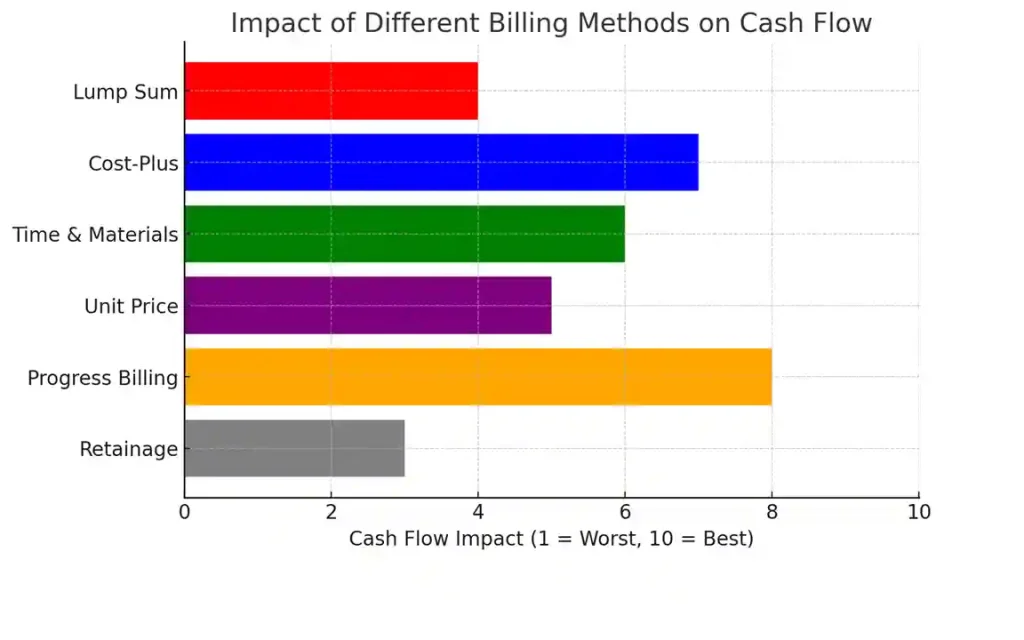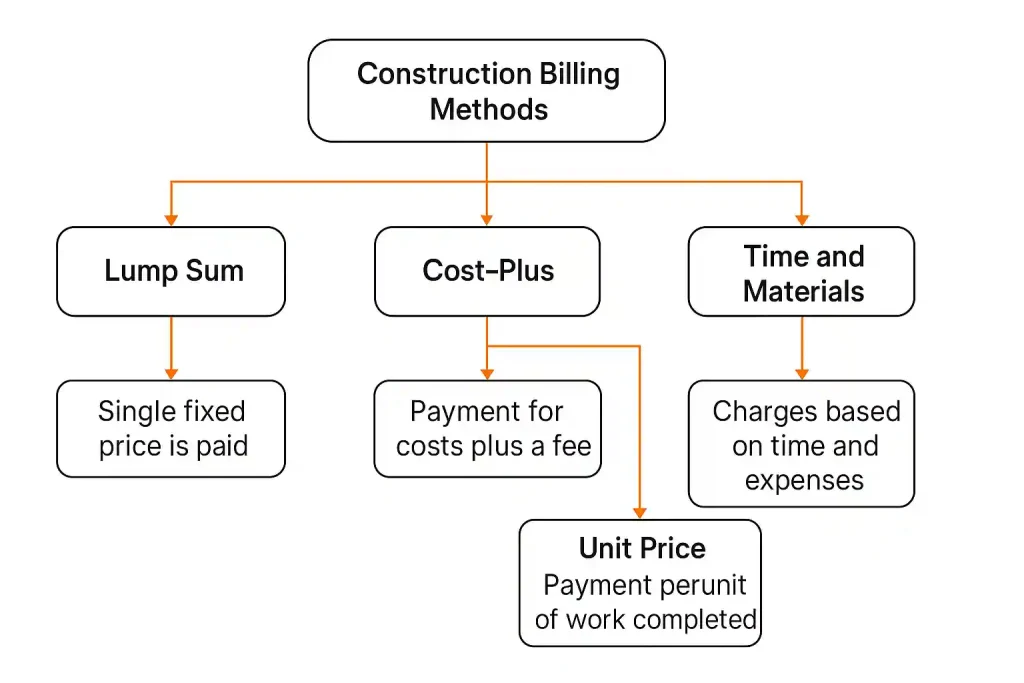Over 80% of contractors report delays in payment.
For many, those delays stretch from weeks into months. You pay your workers and buy what you need, but you’re still asking the client to send your money.
Late payments don’t frustrate—they threaten survival. More than half of construction businesses that shut down cite cash flow as the main reason.
You can build the best project in the city, but if the billing system gets break, you lose.
What Is Construction Billing?
Construction billing is the process of tracking, documenting, and requesting payment for work done on a project. But in this industry, it’s not as simple as sending a basic invoice.
Every job is different. You may be working under a fixed contract, a cost-plus agreement, or progress billing using AIA forms. Each one comes with its own set of rules, risks, and paperwork. And if you don’t follow them exactly, payment gets delayed—or denied.
Construction billing is about getting paid for what you’ve delivered, in a way that both you and your client can agree on. But it’s also about:
- Protecting your margin
- Covering project risk
- Avoiding disputes
- Maintaining steady cash flow
When done right, billing keeps the project moving. When done wrong, it stalls everything.
Why Billing Method Matters More Than You Think
Think of your billing method as a safety net—or a trap. 60% of contractors who fail cite cash flow as the reason. It’s not because they don’t know how to build. It’s because the money didn’t show up on time. If your billing method isn’t designed to protect you from delays, overruns, or disputes, you’ll feel the pain fast.
Understanding the Construction Billing Workflow
At the top of the chart is the central question every contractor must answer before starting a job:
➤ Which Construction Billing Method Should I Use?
This choice determines:
- How you’ll get paid
- How often you’ll invoice
- How much risk you take on
- How disputes will be avoided (or invited)
Construction Billing Methods—the chart breaks out into four major categories:
1. Lump Sum Billing
→ “Single fixed price is paid”
How it works:
- You agree to a total price for the entire project before it begins.
- This number includes labor, materials, overhead, and your profit margin.
- You typically submit one or more invoices at major milestones, or when the project is complete.
Key Insights:
- This is the simplest to understand for the client.
- You carry all the cost risk—if labor or materials go over budget, you absorb the hit.
- Any change in scope must be carefully documented and approved with change orders.
Risk:
A small estimating error can cost you your margin—or worse.
2. Cost-Plus Billing
→ “Payment for costs plus a fee”
This method branches further into another approach: Unit Price, explained next.
How it works:
- You track every expense—materials, labor hours, rentals.
- You then invoice for actual costs, plus a fee (either a flat amount or percentage markup).
- It requires a high level of transparency and trust with your client.
Key Insights:
- Ideal for jobs where the scope is still evolving or not fully defined.
- You must maintain detailed records, including receipts, timesheets, and invoices.
- Disputes arises when the paperwork is messy or when the client doesn’t know what they’re paying for.
Risk:
Without clean tracking, you risk not getting paid or facing delays.
3. Unit Price Billing
→ “Payment per unit of work completed”
This flows from both Cost-Plus and stands as its own hybrid.
How it works:
- Instead of giving one big price for the whole job, you agree on smaller prices.
Ex: Like how much the client will pay you for each cubic yard of concrete or each foot of pipe you put in.
- You get paid based on measured quantities of work completed.
Key Insights:
- This method gives you flexibility and some protection against unknowns.
- It’s often used in civil or infrastructure projects, where large, repeatable quantities are involved.
- You still need strong quantity tracking and client sign-offs to avoid disputes.
Risk:
Overlooked quantities or inaccurate tracking will cost you money—and trust.
4. Time and Materials (T&M) Billing
→ “Charges based on time and expenses”
How it works:
- You bill the client for every hour worked and every material purchased.
- This method is highly granular and demands detailed daily logs.
- It’s common on small jobs, service work, or emergency repairs where scope is not clear at the start.
Key Insights:
- T&M provides full flexibility—you can start work fast without finalizing all project details.
- Clients need to see frequent updates and itemized invoices.
- Markup on labor and materials may apply, but must be agreed upon upfront.
Risk:
Sloppy tracking = unpaid work. And poor communication = mistrust.

This chart shows how different billing methods affect your cash flow—the money you need to keep your project running.
Progress billing works best because it lets you get money as you finish parts of the job. That helps you keep paying your team and covering your costs. Cost-plus and time & materials also help keep cash coming in regularly.
The lump sum and unit price are riskier since you often wait longer to get paid. Retainage is the hardest on cash flow because a part of your payment is held back until the end.
Picking the right way to bill can help your project run smoothly. Picking the wrong one can led to big money problems
How MetaConstructX Fits Into This Workflow
No matter which method you pick—or if you use more than one—you need to stay in control, work fast, and keep everything clear. That’s where MetaConstructX becomes essential:
🔹 Automatically structures invoices for lump sum, T&M, cost-plus, unit price, or AIA-style billing
🔹 Tracks all receipts, labor hours, and quantities
🔹 Keeps documentation audit-ready
🔹 Reduces billing disputes through transparency
🔹 Integrates retainage and change order tracking
Whether you’re billing monthly, weekly, or by milestone, MetaConstructX helps ensure you don’t leave money on the table. In a tight-margin industry, that can make or break your next bid.
Why the Right Billing Method Matters
Every billing method has strengths and risks. Choose wrong, and you can:
- Wait months for payment
- Burn time fixing disputes
- Lose trust with your client
- End up underwater—even after finishing the job
Choose right, and you:
- Get paid faster
- Track progress with confidence
- Stay flexible and protected
- Keep your crews moving and cash flowing
This isn’t just paperwork—it’s how you stay in business.
If your billing doesn’t support your work, it’s working against you. And in this industry, delay is danger.
Keep things simple. Bill accurately, track easily, and get paid faster with MetaConstructX – Schedule a Demo




